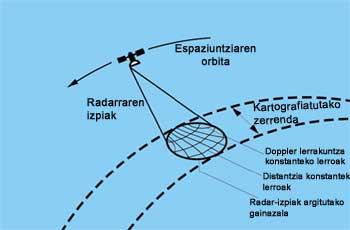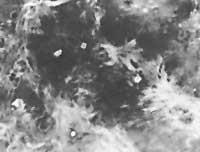Under the clouds of Venus (I)
1992/05/01 Arregi Bengoa, Jesus Iturria: Elhuyar aldizkaria
Attempts to overcome the cloud barrier of Venus to the surface of the planet began long ago. These tests have always been based on the use of radar, because centimetric waves can smoothly cross the cloud layer. Around 1960 the first radars of sufficient power were built to receive echoes returned by Venus, and the first observations were made in the conjunction of 1961, repeating in successive conjunctions. It was a problem.
It is very difficult to perform altimetric measurements from the ground. Therefore, starting in December 1978 it was thought to place an altimetric radar in the Pioneer Venus I that was going to orbit Venus. (This space was specially designed for the study of the atmosphere). The resolution of the altimeter was 200 m. The radar of horizontal measures, meanwhile, is around 100 km.
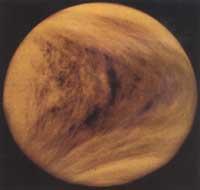
It is not a big thing if we take into account that in suitable conditions structures of between 10 and 20 km of the Earth could be separated, but in return Pioneer I sent images of 93% of Venus, much more than could be cartographed from the Earth. Since then, in the last decade, Venera received images of 15 and 16 kilometers and a half of resolution. However, only a very general view of Venus was achieved. In recent times, through the radars of the Magellan space, scientists are “seeing” much more accurately.
After fifteen months and a journey of more than 1.5 billion kilometers, the Magellan space began orbiting on August 10, 1990. After several communication problems in the first days, September 15 of the same year began mapping the planet. Currently 98% of the data arrive without problems. The first cycle of 8 months of cartography ended on May 15, 1991. Making 6,000 tours around the planet, he has analyzed 90% of the surface of Venus. In the second cycle that has ended at the beginning of the year, it has covered the mistakes made in the first and will also send information on the southern latitudes that were discarded in the first cycle.
To do this, he had to order some orbit changes from Earth. In about five years he will complete 8 cycles, thus improving the resolution and, ultimately, will send images of the entire surface, as sent 20 years ago Mariner 9 from Mars. But there is a difference. Magellan sent more data for three days to Mariner 9 than throughout the mission. Without a doubt, radar images are ininterpretable with respect to the photos, as can be seen in the information we are going to offer, but scientists have already given an overview of the planet after the provisional analysis of the data sent by Magellane throughout the first cycle.
If we compare it with Earth and stick to the first impression, the appearance of Venus is similar to that of our planet in the first stage of its evolution, that is, similar to that of the newly created Earth since the surface was hardened (about 4.5 billion years ago) until shortly before life arose (2.5 billion years ago). This does not mean that the surface of Venus is so old. On the contrary, the oldest incidents identified on the surface seem not to exceed 1,000 million years and most are not estimated to be more than 400 million years old. Therefore, the surface age of Venus ranges from that of Earth (hundreds of millions of years) to that of Martitz, Mercury or the Moon (a few billion years).
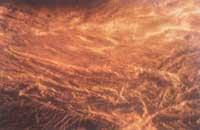
As for its composition, the surface of Venus is similar to the bottoms of the terrestrial seas. However, due to the high temperature of the planet, the rocks are halfway to the melting point, so it is considered that they will act as the soft rocks of the continents.
On the other hand, Venus is a relatively flat planet. 60% of the surface is within a height difference of 1 kilometer. The percentage reaches 80% if the height distance is 2 km. The highest territories, above the average height of the surface, that is, above the average value of the radius (6,051.4 km), are only 5%, and we could say that they are the continents of Venus. They are mainly two: Ishtar Terra and Aphrodite Terra.
Ishtar Terra is located in the northern hemisphere, in relatively large latitudes, and is about the size of Australia. It has a great plain called Lakshmi Planum. On the southern border of this plain are the Danu mountains, about 500 m above, descending about three thousand meters on the other side to the southern plains. In Ishtar is also the highest level of Venus, Mount Maxwell, 11 km above the middle level. Aphrodite Terra is not as tall as Ishtar Terra, but wider. From this point of view we cannot say that the Earth and Venus resemble much. On our planet 65% of the earth is underwater and 35% are continents. In addition, much of the underwater territories are 5 or 6 km below sea height.
Earlier we talked about the age of the surface of Venus, limiting it between that of Earth and that of Mars or Mercury. This means that the surface has undergone modifications or innovations. What mechanisms have participated in this evolution? In the beginning, the general impression of scientists is that the arrangement has been made by agents very similar to those that have taken place on Earth, such as bulcanisms, meteorite shocks, plate tectonics and erosion. However, there are others who do not see the problem clearly, because on Earth and Venus the results have been quite different. There are significant differences in the development of these processes. Let's see.
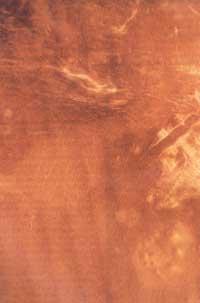
The most powerful process has been that of volcanoes. At least 80% of the surface of Venus, vulcanism is the last geological process that has occurred. Therefore, in the last hundred thousand years the surface has been practically restored. It cannot yet be determined whether the process was the result of a major catastrophe or small eruptions over many years.
The influence of meteorite impacts is also not the same as has occurred on the Moon or on planets with a thin atmosphere. Due to its density, the atmosphere of Venus is a great obstacle for meteorites who want to arrive. The smaller ones get undone before reaching the ground, while the older ones divide. However, impact driven craters from more than 20 km have generated lava flows. Surprisingly, there is no region throughout Venus that preserves the craters of the first era of the Solar System, as in the southern highlands of the Moon.
As for tectonics, it has its place on Venus. In a small proportion of the surface on which volcanic activity has not arrived, we have been able to appreciate evidence of plate movement. In fact, different structures can be found on both continents. Ishtar Terra is the most unique and incomprehensible region: they are mosaic regions formed by tesserae located one or two kilometers above the volcanic plains. On the other hand, there are those who believe that Ishtar is due to the accumulation of the surface.
It is believed that the structure of Aphrodite Terra could also be a consequence of tectonics, but the process has not yet been clarified. However, it is clearly observed that the behavior of Venus tectonics is different from that of Earth.
Erosion is the least important agent of Venus. It prevents erosion caused by the atmosphere, the Moon or the micrometeorites that support Mercury, and on the other hand, the planet is so dry that it should not be affected by the water that supports the Earth. We have the wind as the only agent and not having much force on the surface, it causes very small changes.
On this occasion I wanted to give an overview. In the following we will delve deeper into the details to better understand how research is conducted and what it is based on
EPHEMERIS SUN: 20 May, at 19 h 12 m enters Gemini.
PLANETS
|

Gai honi buruzko eduki gehiago
Elhuyarrek garatutako teknologia





